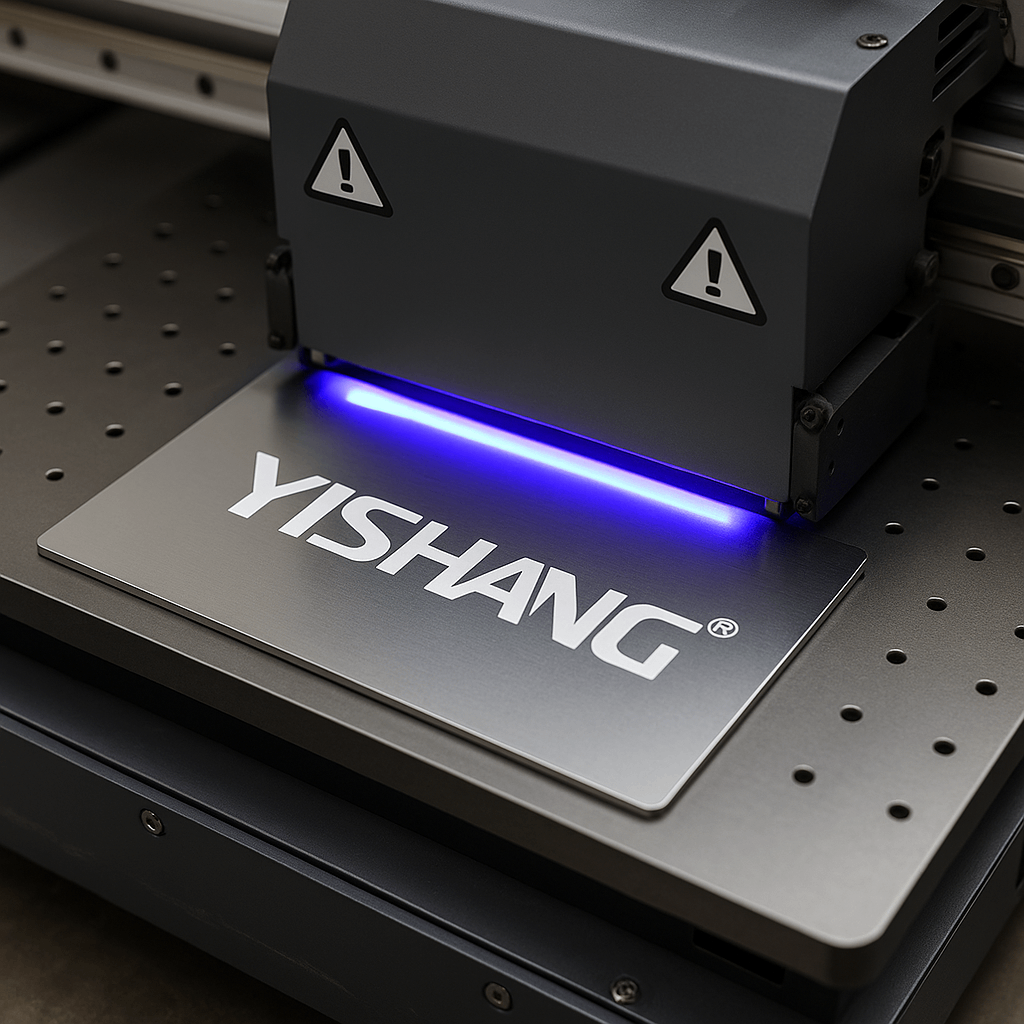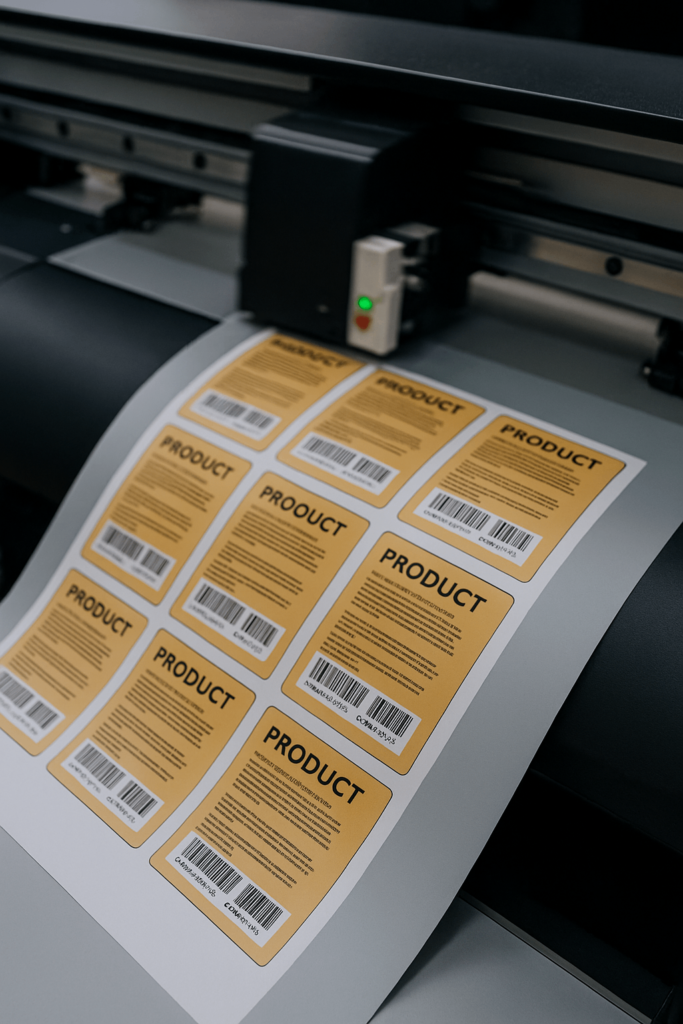Introduction: Don’t Just Print—Print with Purpose
In international manufacturing, B2B buyers need more than surface-level quality. Consistency, adhesion, and cost-efficiency in printing are central to procurement outcomes—especially for custom parts, metal housings, or industrial-grade labels. For global wholesalers and sourcing agents, choosing between UV and digital printing means evaluating risks, not just specs.
This article from YISHANG, with over 26 years in OEM/ODM metal component production and exports to 50+ countries, compares the two methods through real manufacturing scenarios. The focus is clear: which printing technology delivers the most reliable results for bulk production, durable industrial labels, and custom enclosures?
UV Printing in Manufacturing Contexts
UV printing is engineered for metal enclosures, powder-coated housings, and non-absorbent surfaces. The UV ink cures instantly under ultraviolet light, bonding directly to coated substrates like anodized aluminum and polycarbonate—without extensive surface preparation.
For procurement managers, this means fewer rejected parts, tighter tolerance on print placement, and lower long-term rework costs. From HVAC panels to kiosk doors, UV printing delivers high-resolution branding and compliance icons that won’t fade or peel.
At YISHANG, our clients frequently select UV printing for:
Branded control panels in vending and telecom cabinets
CE, UL, and RoHS-compliant marking on steel enclosures
Outdoor-durable labeling for aluminum casing parts
This method is proven across key performance metrics—ASTM D3359 for adhesion, ISO 15184 for hardness, and ISO 6270 for humidity resistance. If your contract hinges on durable, regulation-ready output, UV printing is your safest choice.
Digital Printing: Strength in Flexibility for Variable Product Needs
Digital printing excels when procurement requires fast sampling, multiple SKUs, or product variation across markets. It’s a go-to for light-duty packaging, inner box branding, or rapid versioning without tooling or downtime.
LSI queries like “digital label printing vs UV” often arise when customers weigh speed against longevity. While digital performs well on coated paper or films, it lacks durability on metal unless laminated. For many, it’s ideal for:
Quick-turn product pilots
Barcode series for regional distribution
Paperboard packaging with seasonal campaigns
Buyers seeking lower MOQs, faster approval, and visually vibrant output may find digital useful in the pre-launch or low-risk packaging phase. But when the product is intended for long-term use in demanding conditions, UV remains more suitable.
Material Compatibility for Industrial Substrates
When sourcing for industrial applications, not every substrate supports every printing method. Understanding substrate printing compatibility early prevents costly redesigns or delayed fulfillment.
| Material Type | UV Printing | Digital Printing |
|---|---|---|
| Powder-Coated Steel | ✓ | ✕ |
| Anodized Aluminum | ✓ | ✕ |
| Acrylic & Polycarbonates | ✓ | Limited |
| Coated Paper | ✓ | ✓ |
| Vinyl/PVC | ✓ | ✓ |
| Fiberglass Panels | ✓ | ✕ |
Which printing method is better for powder-coated steel? Without question, UV offers stronger adhesion, image clarity, and weatherproofing. Digital can’t bond reliably to such surfaces without pre-treatment and lamination, which undermines cost control.
Durability and Regulatory Reliability for Printed Parts
Label durability directly affects compliance, customer perception, and product lifecycle cost. When a barcode fades or a compliance label detaches, your customer’s audit—and your credibility—are at risk.
UV inks pass salt spray tests (ASTM B117), UV fade testing (ASTM G154), and abrasion standards (ASTM D4060), making them ideal for metal parts used outdoors or in high-humidity zones.
Can digital printing be used on aluminum? Not for high-performance needs. Without lamination, digital inks often fade or scratch off anodized and coated metals within weeks. Buyers working with outdoor panels, junction boxes, or medical-grade casings typically choose UV for this reason.
Color, Readability & Image Accuracy
UV printing delivers bold, high-contrast images—even on dark or glossy substrates. The cured ink layer resists smudging, offers raised tactile effects, and ensures brand consistency across thousands of units.
Digital printing is optimal for brochures, inserts, and temporary packaging. It supports gradients, fine text, and variable content. However, in batch printing consistency over 500+ units, UV holds tighter color tolerance and visual integrity—critical for branded industrial labels.
For sourcing managers comparing batch printing consistency across thousands of parts, UV minimizes color drift and delivers uniform print appearance over time.
Cost & Volume: Forecasting Procurement Value
Budget planning requires understanding how unit cost shifts at scale. Here’s how UV and digital printing compare across typical order sizes:
| Quantity | UV Print (USD/unit) | Digital Print (USD/unit) |
| 50 | $2.70 | $2.20 |
| 500 | $1.15 | $1.70 |
| 2000 | $0.60 | $1.30 |
Digital wins for short runs and marketing kits. But beyond 300–500 units, UV delivers both lower cost and superior endurance—especially when factoring in returns, label failure, or compliance issues. Several YISHANG clients saw up to 30% cost savings per project after switching to UV.
Procurement Scenarios: When to Use Which Method
Choose UV Printing if you need:
UV printing for metal enclosures or outdoor-rated labels
Compliance-ready tags with scratch/chemical resistance
Industrial asset ID or laser-alternative solutions
Choose Digital Printing if you need:
Small-run product launches with visual appeal
Temporary packaging or lightweight boxes
Multi-language or serialized label data (short term)
Choose both when:
You want a digital sample for visual approval, then UV for production
You need packaging + technical label printing from one vendor
Hybrid Print Workflow for Agile Production Teams
Many procurement teams now adopt a blended workflow—digital for early-stage prototyping, UV for final delivery. This reduces change order delays and aligns better with agile product cycles.
At YISHANG, we support this hybrid model with:
Color-calibrated consistency across technologies
Batch tracking and file version control
Cross-process proofing for dual-component BOMs
Spec file validation support during onboarding
Technical print feasibility review to reduce approval time
MOQ flexibility for proofing and low-volume production
RFQ-compatible labeling requirements for faster procurement alignment
The result: smoother supplier communication, faster approvals, and fewer surprises at scale. These processes also reduce unit rejection rates significantly—backed by case studies across electronics and energy sectors.
Conclusion: Match Print Technology to Procurement Priorities
For global buyers in metal parts sourcing, the goal isn’t just high-resolution printing—it’s label performance that meets industrial conditions, regulatory expectations, and cost targets.
If your project involves durable industrial labels on substrates like aluminum, steel, or composite panels, UV printing offers clear advantages.
If you’re testing SKUs, running promotional campaigns, or need fast data changes, digital printing handles early-phase demand effectively.
YISHANG supports both technologies—and advises on which suits your BOM, lifecycle requirements, and logistics chain.



